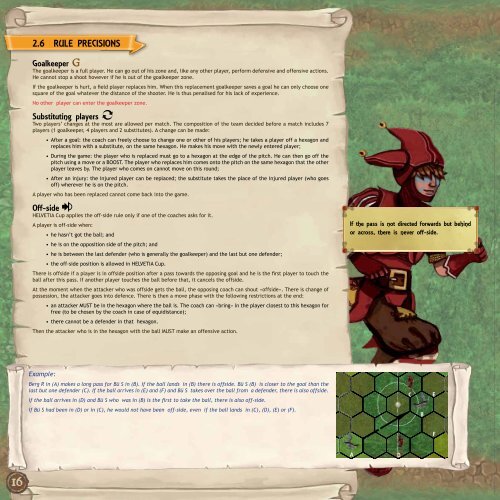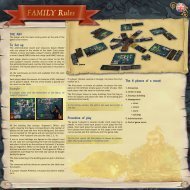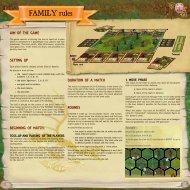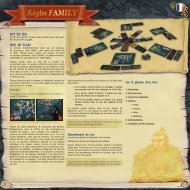Download GEEK rules (14.2 Mo) - HELVETIA Games
Download GEEK rules (14.2 Mo) - HELVETIA Games
Download GEEK rules (14.2 Mo) - HELVETIA Games
- No tags were found...
Create successful ePaper yourself
Turn your PDF publications into a flip-book with our unique Google optimized e-Paper software.
82.6 RULE PRECISIONSGoalkeeper GThe goalkeeper is a full player. He can go out of his zone and, like any other player, perform defensive and offensive actions.He cannot stop a shoot however if he is out of the goalkeeper zone.If the goalkeeper is hurt, a field player replaces him. When this replacement goalkeeper saves a goal he can only choose onesquare of the goal whatever the distance of the shooter. He is thus penalised for his lack of experience.No other player can enter the goalkeeper zone.Substituting playersTwo players’ changes at the most are allowed per match. The composition of the team decided before a match includes 7players (1 goalkeeper, 4 players and 2 substitutes). A change can be made:• After a goal: the coach can freely choose to change one or other of his players; he takes a player off a hexagon andreplaces him with a substitute, on the same hexagon. He makes his move with the newly entered player;• During the game: the player who is replaced must go to a hexagon at the edge of the pitch. He can then go off thepitch using a move or a BOOST. The player who replaces him comes onto the pitch on the same hexagon that the otherplayer leaves by. The player who comes on cannot move on this round;• After an injury: the injured player can be replaced; the substitute takes the place of the injured player (who goesoff) wherever he is on the pitch.A player who has been replaced cannot come back into the game.Off-side<strong>HELVETIA</strong> Cup applies the off-side rule only if one of the coaches asks for it.A player is off-side when:• he hasn’t got the ball; and• he is on the opposition side of the pitch; and• he is between the last defender (who is generally the goalkeeper) and the last but one defender;• the off-side position is allowed in <strong>HELVETIA</strong> Cup.There is offside if a player is in offside position after a pass towards the opposing goal and he is the first player to touch theball after this pass. If another player touches the ball before that, it cancels the offside.At the moment when the attacker who was offside gets the ball, the opposing coach can shout «offside». There is change ofpossession, the attacker goes into defence. There is then a move phase with the following restrictions at the end:• an attacker MUST be in the hexagon where the ball is. The coach can «bring» in the player closest to this hexagon forfree (to be chosen by the coach in case of equidistance);• there cannot be a defender in that hexagon.Then the attacker who is in the hexagon with the ball MUST make an offensive action.If the pass is not directed forwards but behindor across, there is never off-side.152/7/1314 198181/3/612/201617104/5/11Example:Berg R in (A) makes a long pass for Bü S in (B). If the ball lands in (B) there is offside. Bü S (B) is closer to the goal than thelast but one defender (C). If the ball arrives in (E) and (F) and Bü S takes over the ball from a defender, there is also offside.If the ball arrives in (D) and Bü S who was in (B) is the first to take the ball, there is also off-side.CEIf Bü S had been in (D) or in (C), he would not have been off-side, even if the ball lands in (C), (D), (E) or (F).B14 192/7/13F915181/3/612/201016174/5/11AD16






